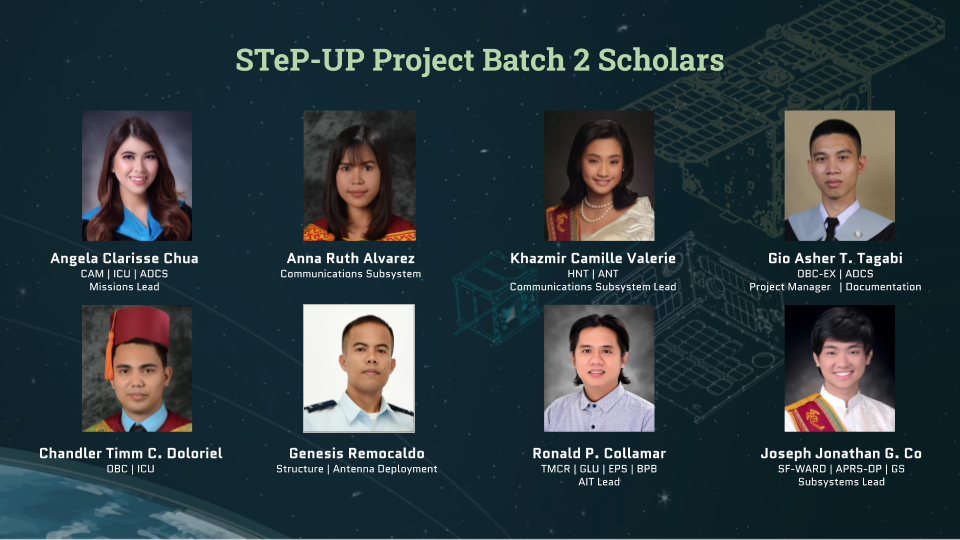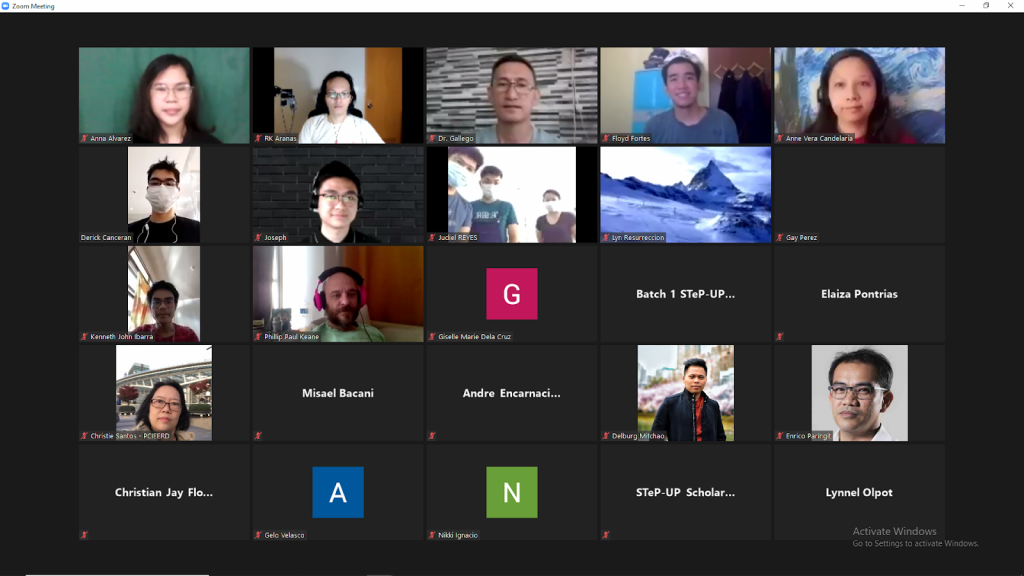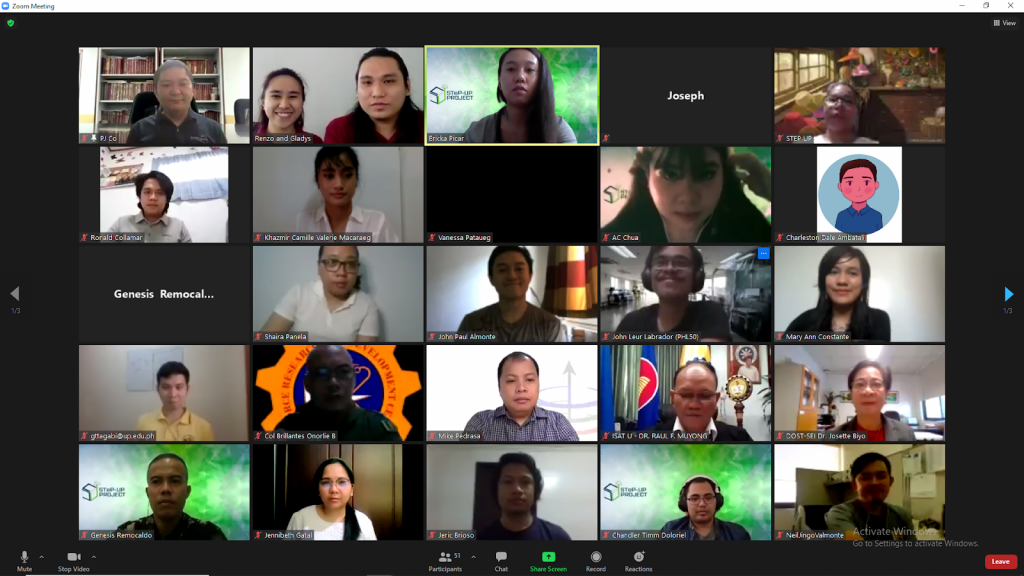The pandemic is an unusual backdrop for eight young researchers across the country who are studying how to build powerful satellites that could fit within the palm of their hands.
Riddled with difficulties such as flaky internet connection, and device limitations, they are being pushed beyond their comfort zone yet they remain steadfast in their goal — to build and launch nanosatellites into space within the next two years.
These eight young researchers are the latest batch of scholars of the Space Science Proliferation through University Partnerships Project (STeP-UP Project), a graduate program with a nanosatellite engineering track housed within the University of the Philippines Diliman Electrical and Electronics Engineering Institute (UPD EEEI). The project receives continuous support from the Department of Science and Technology-Science Education Institute (DOST-SEI). At the core of this project is the aim to proliferate knowledge gained in building microsatellites and nanosatellites to local universities through inter-university collaboration and the design and teaching of subjects or courses on small satellites.
The scholars Gio Asher Tagabi, Joseph Jonathan Co, Ronald Collamar, Chandler Timm Doloriel, Genesis Remocaldo, Anna Ruth Alvarez, Angela Clarisse Chua, and Khazmir Camille Valerie Macaraeg were introduced to the public in an online event on November 6, 2020.
Hailing from different provinces and cities across the country, these scholars are studying to become responsible contributors to the space science and technology ecosystem of the country.
In the event, STeP-UP Project Leader Paul Jason Co said, “If we want to build our own local space industry, more needs to be done. The STAMINA4SPace program undertakes the next step, which is to take this knowledge back home and build up our capabilities and cultivate our space science technology and applications ecosystem.”
“In order to build and sustain this ecosystem, the academe must ensure that capable researchers and scientists and engineers will continue to be developed that will sustain this industry and ecosystem.”
Once in a lifetime opportunity
Angela Clarisse Chua, who came from Sta. Cruz, Manila, has learned about the STeP-UP Project by following the STAMINA4Space Facebook page. She found it as a good opportunity to take part in the space science field of the country.
She believes that the budding Philippine space science industry could help inspire more Filipinos to help the country improve in science and technology.
For Khazmir Camille Valerie Macaraeg of Quezon City, space is her passion. “I’ve always been fascinated with space,” she said.
“It amazed me that our country is taking steps to leave a long-lasting mark in space. So when I heard about the opening of applications for the second batch of scholars for the nanosatellite track, I knew I had to try and send in my application,” she added.
Meanwhile, for 2nd Lt. Genesis Remocaldo, the scholarship for the Master’s degree in Electrical Engineering is a once in a lifetime chance for uniformed personnel to be able to to study in a program closely aligned to his academic expertise.
“I also hope to bring collaborative opportunities to the Philippine Air Force related to national space activities connecting our organization closer to scientific/academic stakeholders,” said Remocaldo.
Overcoming the challenges of the pandemic
However, current quarantine restrictions posed some challenges to these scholars. A lot of them face technical difficulties. To add to that, they have limited access to laboratories and equipment for their studies.
Gio Asher Tagabi, who also serves as the Project Manager of the group, plans on turning part of his apartment in Quezon City into a workshop and laboratory in the meantime. “I buy my own equipment and tools so I can continue testing and working on my part of the satellite here in my apartment,” he said.
Others like Chandler Timm Doloriel and Ronald Collamar found this as an opportunity to maximize their research time.
“I read and research as much as I can. For now, I always scan the previous documents of BIRDS-4 to familiarize the test and verification I need to do when we need to do the actual testing in UPD,” Doloriel of Surigao City, Surigao del Norte said.
“I am maximizing my time by setting daily targets on my own. It is quite an advantage that my anticipated travel time to and from the school was converted into more time for me to study,” said Collamar, who hails from Hagonoy, Bulacan.
Fulfilling the dream to send satellites to space
Still, Doloriel looks forward to meeting with the rest of the team and building the satellite for the country. He is excited about “the thought that we are building this nanosatellite for the purpose of inspiring young Filipinos to follow the path of space science and technology, and give them the hope that maybe in their time there will be Filipino astronauts in space.”
Similarly, Anna Ruth Alvarez from Clarin, Misamis Occidental thinks that the program gives them a “national sense of purpose” as they’re building satellites for the benefit of the country.
“I look forward to seeing our developed satellites, orbiting and operating, in space,” said Joseph Jonathan Co of Valenzuela City.
The satellites the team is building follow the first Philippine-university built cube satellites Maya-3 and Maya-4. Maya-5 and Maya-6 are also 10-cubic centimeters nanosatellites with payloads such as sensors and cameras similar to that of their predecessors. While they develop the satellites in the Philippines, these will undergo space environment testing in Japan, something the scholars are looking forward to, together with the anticipated launch of these cubesats into space.



